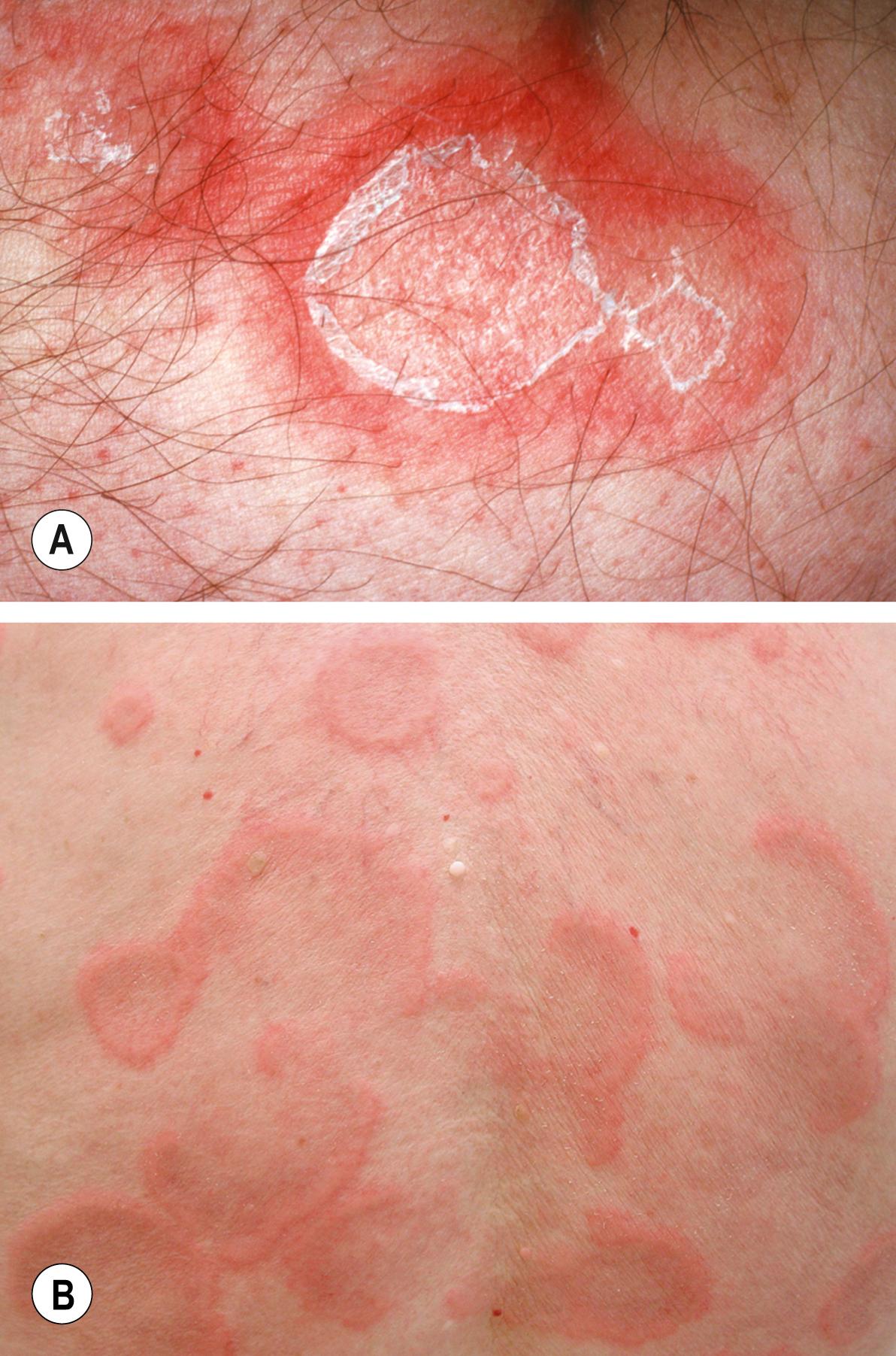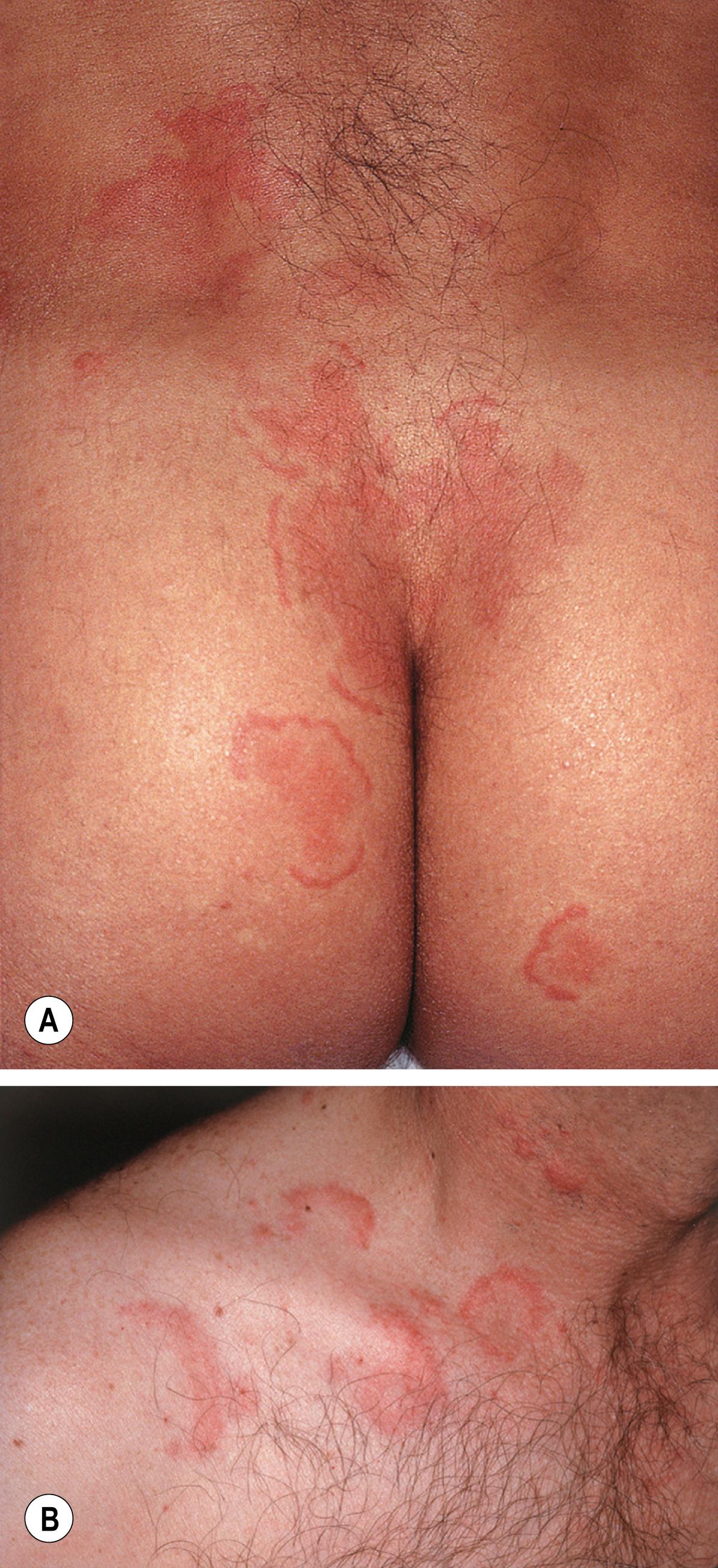Physical Address
304 North Cardinal St.
Dorchester Center, MA 02124
A number of cutaneous diseases can have an annular, arciform, or polycyclic configuration, from urticaria to granuloma annulare and tinea corporis ( Table 15.1 ). Sites of involvement, rate of expansion, and characteristics of the border assist in narrowing the differential diagnosis, along with histopathologic examination of the active edge. This chapter discusses in more detail the classic figurate erythemas.
| No epidermal (surface) changes | |
|---|---|
| Annular urticaria | Individual lesions are transient, lasting <24 hrs |
| Urticaria multiforme | Migratory edematous plaques that may have dusky centers; edema of the face, hands and feet can develop; primarily in infants and young children, often following a viral or bacterial infection |
| Serum sickness-like eruption | Urticarial (or morbilliform) eruption due to a systemic medication; may be accompanied by arthralgias, arthritis, and fever |
| Urticarial vasculitis | Individual lesions usually last >24 hrs and may resolve with petechiae |
| Granuloma annulare | Skin-colored to dull pink elevated border, often composed of coalescing papules; favors acral sites, elbows |
| Annular elastolytic giant cell granuloma | Chronically sun-exposed sites with significant photodamage; hypopigmented centrally as expands |
| Interstitial granulomatous dermatitis | Associated with autoimmune connective tissues diseases, e.g. rheumatoid arthritis, and systemic medications, e.g. TNF inhibitors |
| Sarcoidosis | Skin-colored to red-brown; with pressure (diascopy), has a yellow-brown color; face > trunk, extremities; sometimes has scale |
| Leprosy | Primarily tuberculoid and borderline forms, with the former often having central hypopigmentation |
| Syphilis | Secondary stage, in particular on the face, and tertiary stage (gummas); facial lesions may have central hyperpigmentation |
| Annular erythema of infancy | Slowly expanding with an urticarial border; individual lesions spontaneously resolve over a few days |
| Benign lymphocytic infiltrate (of Jessner) | Favors the head, neck, and upper trunk; erythematous papules and plaques last weeks to months |
| LE tumidus | Firm erythematous plaques that favor the face and upper trunk |
| Lymphoma cutis, both B- and T-cell | Pink to violet papules and plaques; may be primary cutaneous or related to a systemic lymphoma; some subtypes of CTCL, e.g. mycosis fungoides, can have scale |
| Scale and/or crust | |
|---|---|
| Tinea corporis | Scale and pustules in the advancing border; KOH examination is positive for hyphae |
| Seborrheic dermatitis | Lesions on the face and central chest; associated scale |
| Annular psoriasis | Scale is silvery; associated scalp, intergluteal, and nail involvement |
| Subacute cutaneous LE | Primarily sun-exposed sites, especially upper trunk and upper outer arms; hypopigmented centrally |
| Elastosis perforans serpiginosa | Border contains keratotic papules and lesions favor flexural sites |
| Wickham striae within border | |
|---|---|
| Annular lichen planus | The elevated border is string-like |
| Petechiae within border | |
|---|---|
| Annular capillaritis | Both petechiae and yellow-brown hue due to hemosiderin |
| Vesicobullae within border | |
|---|---|
| Linear IgA bullous dermatosis | Border may resemble “string of pearls”; DIF required |
| More serpiginous border | |
|---|---|
| Cutaneous larva migrans | Favors feet, buttocks, and areas in contact with sandy ground |
Annular, arciform, and polycyclic plaques due to infiltrates of lymphocytes within the dermis; lesions usually last for a few weeks to months and as they migrate centrifugally, there is central clearing; recurrences are common.
This gyrate erythema is sometimes divided into superficial and deep forms, based on clinicopathologic findings, with the superficial form being minimally elevated with “trailing” white scale ( Fig. 15.1A ) and the deep form having a more infiltrated border ( Fig. 15.1B ); some authors reserve the designation EAC for the superficial form.

Color varies from pink to darker red-violet, with the superficial form favoring the thighs and the deeper form the trunk; peak incidence is during the fifth decade.
Often idiopathic, but some cases appear to be a reactive process triggered by fungal infections, in particular tinea pedis, or less often, viral infections or medications.
DDx: Tinea corporis (especially if scale is present); if no surface changes, annular urticaria ( Fig. 15.2 ), benign lymphocytic infiltrate (of Jessner), cutaneous lymphoid hyperplasia, cutaneous lupus erythematosus (tumidus), and lymphoma cutis as well as the other entities covered in this chapter and Table 15.1 ; in some patients, the diagnosis of EAC is rendered after exclusion of other disorders.

Rx: if trigger identified, it should be treated; if no trigger is identified, topical CS may be of some benefit.
Become a Clinical Tree membership for Full access and enjoy Unlimited articles
If you are a member. Log in here